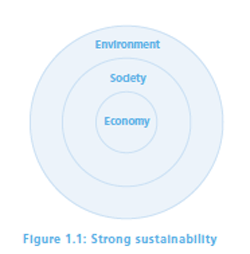Aspects of sustainability
Sustainability requires consideration of four aspects (sometimes also known as perspectives, pillars).
The four aspects
While all four aspects of sustainability are important, environmental sustainable is fundamental to the kaitiakitanga of our environment.
Environmental – this aspect acknowledges the need to enhance and maintain the biophysical systems that sustain all life on Earth. It includes the structure and function of natural ecosystems and the interactions between them and people, and calls for guardianship/kaitiakitanga of our environment.
Social – this aspect acknowledges the need for equity within and between generations, and within and between ethnic and social groups. It is inclusive of people’s mental and physical well-being and the cohesion of their communities based on a fair distribution of resources.
Cultural – this aspect acknowledges the need to nourish and share attitudes and values that represent diverse worldviews, and the political need for all people to express their views freely and to participate in decision-making. Addressing these needs can build resilience for the future.
Economic – this aspect acknowledges the interactions of humans with the natural environment in using resources to create goods and services which add value to their lives. It acknowledges the resource use and waste disposal must occur within the capacity of our planet. It encourages a fair trading system that equitably distributes benefits and costs. It further encourages innovation and creativity in developments that lead to a sustainable future.
An integrative model
A model showing how these aspects are related (in this model, the social and cultural aspects sit within society).
(Source:
See Change – Learning and Education for Sustainability, p.15)
There are many different models which show how these aspects are related. This model shows how our economy is a subset of our society, as in reality it is situated entirely within our society. It also shows that everything in our economy and everything in our society is situated within, and entirely dependent on, our environment. This relationship means that any impact or change to our environment will impact on society and the economy, and therefore that any sustainability-related issue must be considered holistically, and recognise this interdependence. For example, a unit on oceans as a sustainable resource might consider the marine ecosystem and how people affect it through fishing and pollution (as in science), the socio-cultural aspects of seafood harvesting (as in geography), and the economic impact of fishing and tourism (economics).
Within subject disciplines one aspect may well be foregrounded in teaching and learning of a sustainability issue, but the other aspects must also be considered to support informed and considered action as an outcome. Where possible, teachers from different subject areas should be invited to share their relevant specialist knowledge. Alternatively, a cross-disciplinary approach can be used where teachers from the different disciplines co-teach the unit (or possibly a whole course).
Last updated December 6, 2022
TOP


